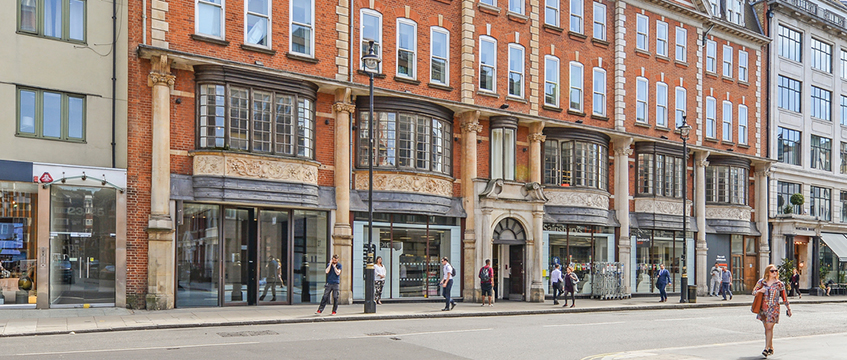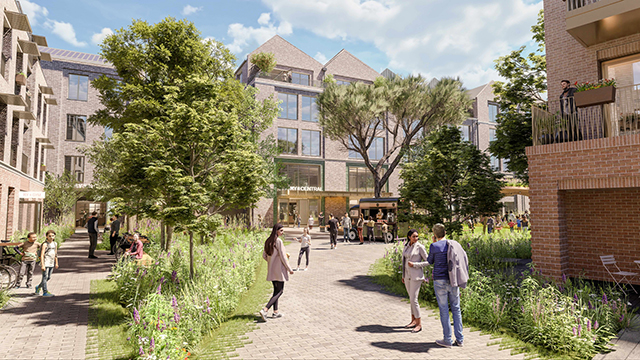“The number one starting point should be the assumption that existing buildings should be retained and retrofitted,” says Jacob Loftus.
“And then we need to design the quantitative and qualitative criteria to determine whether a building should have an exemption from this default position.”
As chief executive of General Projects, the boutique development company he founded in 2016, Loftus is making his mark as a reinventor of existing building stock.
Current projects include the Richard Seifert-designed former Woolworths HQ in Marylebone, NW1, (pictured below) where General Projects and partner Henderson Park briefly weighed up the options of retrofit and extension versus knock-down and rebuild before embarking on the former. With architect AHMM, Loftus says they are creating space equal to what could have been achieved through a rebuild, less the carbon impact. The character of the original architecture will be retained and new space added using a hybrid of steel and timber; 27,000 sq ft of green spaces will be added to a one-acre site which previously boasted no green spaces at all.
He is realistic that not everything can be given such star treatment.
“I think it’s important to go on record and say I would expect that a significant number of buildings would qualify for the exemption, because not every building is going to be appropriate for full retrofit. But hopefully the vast majority should be,” he says.
A growing number of local authorities in central London agree with him and are honing in on the importance of retrofit and retention projects and pushing that narrative onto developers. But, says Loftus, when a local authority asks a developer why they are going for demolition rather than retrofit, there is no framework through which to evaluate the developer’s response.
“It is a bit of a one-sided battle. The criteria haven’t been set and the regulatory framework hasn’t been established, so it is a harder battle for the council to fight,” he says. “There are no set rules for the referee to determine how to keep score and weigh up the balance,” Loftus says. “I think we are missing a referee too.”
Some of this can be addressed through the planning system, he says, by requiring developers to publish the kilograms of carbon that are going to be associated with a project based on different scenarios (covering rebuild and refurbishment) and looking at this alongside the projected annual carbon emissions from the completed building over the next 50 years – again, based on different development scenarios.
“It might be that demolition and rebuild actually looks better over the long term in some cases,” Loftus says. The point is to get the information into the public domain so a judgment can be made, and so the public is better informed about the consequences of the decisions being taken.
But there are many more layers of complexity to any major planning application and decision, Loftus points out. Indeed, the debate around retrofit versus rebuild is such a tangled one because carbon cannot be the only criteria. You might be able to reduce the carbon footprint by retrofitting an existing office but if that building is not going to be best in class or can’t deliver the quality of product end users want or isn’t future-proofed, then saving it from demolition might not be worthwhile.
“You might make the sustainable choice today in retrofitting that building, but find it is unlettable in five or 10 years’ time – and you have produced a huge amount of carbon in retrofitting it,” Loftus says. “If it then needs to be redeveloped or comprehensively changed again in the future, that might not have been the right choice.”
Against this backdrop, Loftus says he would welcome the use of financial incentives to really move the dial.
“If you say there are externalities to society of demolishing a huge building and building something new – carbon, traffic, pollution, etc – one would assume there would be a tax or a disincentive towards that approach as much as there might be an incentive towards the other approach. That would also help push the market towards the more sustainable option. But again, that doesn’t yet seem to be something that is in the wider discourse around the topic.”
Nevertheless, he’s encouraged things are moving in the right direction and sees the furore over M&S’s plans to demolish its flagship Oxford Street store as a welcome sign that embodied carbon has gone from being a “niche” element of sustainability to entering mainstream consciousness.
“Embodied carbon and the re-use of existing buildings has been an inconvenient side to sustainability – it’s not something a lot of people want to put a spotlight onto because it doesn’t chime with the ESG agenda of many of our leading real estate companies.
“Yes, they are building these huge new BREAM outstanding buildings, but they are also demolishing hundreds of thousands of tonnes of existing buildings to get there. The two don’t really chime up, so this has been the bit that hasn’t been focused on,” he says. Not any more.

To send feedback, e-mail julia.cahill@eg.co.uk or tweet @EGJuliaC or @EGPropertyNews











